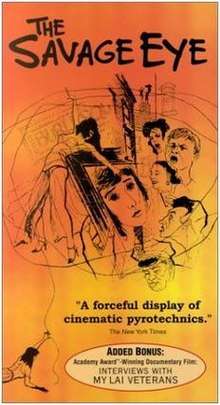The Savage Eye
The Savage Eye is a 1960 "dramatized documentary" film that superposes a dramatic narration of the life of a divorced woman with documentary camera footage of an unspecified 1950s city. The film was written, produced, directed, and edited by Ben Maddow, Sidney Meyers, and Joseph Strick, who did the work over several years on their weekends. The Savage Eye is often considered to be part of the cinema vérité movement of the 1950s and 1960s.
| The Savage Eye | |
|---|---|
 Poster | |
| Directed by | Ben Maddow Sidney Meyers Joseph Strick |
| Produced by | Ben Maddow Sidney Meyers Joseph Strick |
| Written by | Ben Maddow Sidney Meyers Joseph Strick |
| Starring | Barbara Baxley Herschel Bernardi Jean Hidey Elizabeth Zemach Gary Merrill |
| Music by | Leonard Rosenman |
| Cinematography | Jack Couffer Helen Levitt Haskell Wexler |
| Edited by | Ben Maddow Sidney Meyers Joseph Strick |
| Distributed by | Trans-Lux Distributing-Kingsley International |
Release date |
|
Running time | 68 minutes |
| Country | United States |
| Budget | $65,000 |
History
In a 1960 review, A. H. Weiler characterized the film:[1]
... it is from the photographic and sound-track concentration on the Hogarthian faces of Los Angeles that The Savage Eye derives most of its ferocity. The rabid wrestling-match audiences; the middle-aged and elderly ladies seeking improvement of gross bodies in beauty parlors; the sensuous writhings of Jean (Venus the Body) Hidey as she strips and teases in a burlesque joint, and, most effectively, the matter-of-fact faith healer who doles out wholesale blessings on the afflicted (done with a direct voice and sound track) are the most striking glints in The Savage Eye.
Benjamin Jackson has noted that Irving Lerner, Strick's collaborator on the earlier documentary Muscle Beach (1948), "was part of the original group, but left in the middle of production."[2] The camera footage for the film was done over these years by the principal cinematographers Haskell Wexler, Helen Levitt,[2] and Jack Couffer; the sound editing for the film was one of Verna Fields' early credits. The film won the 1960 BAFTA Flaherty Documentary Award as well as several film festival prizes. Reviewing its debut at the 1959 Edinburgh Film Festival, the art critic David Sylvester called its imagery "sharp, intense, spectacular, and imaginative".[3]
John Hagan has written further of the film's influence that:[4] "One can see how, in its study of a woman whose marital problems have estranged her from the world, it anticipated, if not influenced, such films as The Misfits, Red Desert, and Juliet of the Spirits."
The Academy Film Archive preserved The Savage Eye in 2008.[5]
References
- Weiler, A. H. (June 7, 1960). "The Savage Eye (1959)". The New York Times. Retrieved January 9, 2008.
- Jackson, Benjamin T. (Summer 1960). "The Savage Eye". Film Quarterly. 13 (4): 53–57.. A second woman known primarily for her work as a film writer is also named "Helen Levitt." This review, which is perhaps the most comprehensive discussion of The Savage Eye in the literature, clarifies that the cinematography was indeed done by the distinguished photographer of the same name.
- Sylvester is quoted in Miller, Henry K. (2009). "Slow Bloom". Sight and Sound. British Film Institute. Archived from the original on December 2, 2009. Retrieved November 25, 2009.
- Hagan, John (2000). "Ben Maddow". In Pendergast, Tom; Pendergast, Sara (eds.). International Dictionary of Film and Filmmakers, Edition 4. St. James Press. ISBN 978-1-55862-449-8. Retrieved January 9, 2008.
- "Preserved Projects". Academy Film Archive.